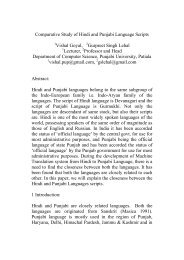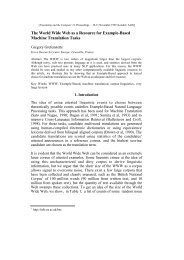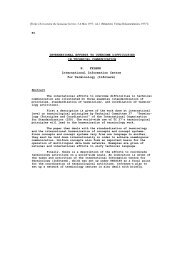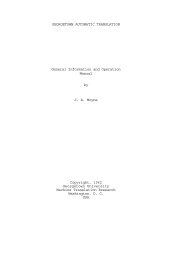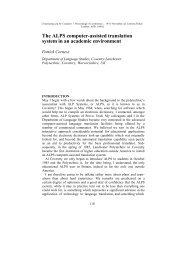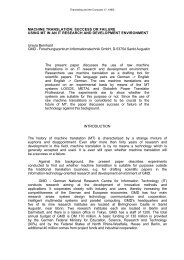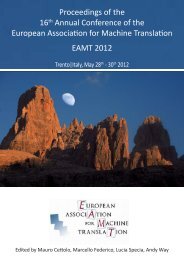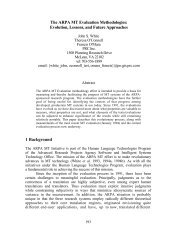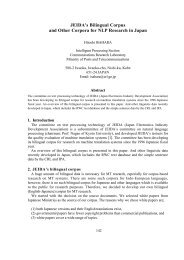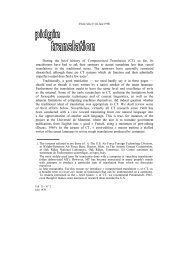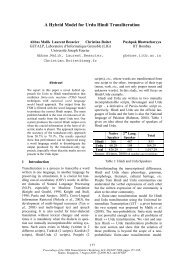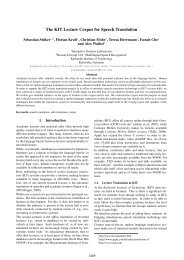Controlled authoring at SAP - Machine Translation Archive
Controlled authoring at SAP - Machine Translation Archive
Controlled authoring at SAP - Machine Translation Archive
You also want an ePaper? Increase the reach of your titles
YUMPU automatically turns print PDFs into web optimized ePapers that Google loves.
(frequently) in the document<strong>at</strong>ion and to ensure th<strong>at</strong> our implemented rules cover all or most variants<br />
of an error type. There are new initi<strong>at</strong>ives <strong>at</strong> <strong>SAP</strong> to establish central copy-editing for all text types and<br />
the SKATE software is currently being used for large-scale language checks (approx. 3200 documents<br />
/ 750,000 words) as part of a quality assurance project for <strong>SAP</strong> R/3 Enterprise document<strong>at</strong>ion. A<br />
secondary aim of this project is to collect valuable d<strong>at</strong>a to adapt the checking rules.<br />
Rule Implement<strong>at</strong>ion<br />
The linguistic processing components of the server process the text sent by the client. As a result the<br />
input text is segmented into sentences and each sentence is split into words or tokens (tokeniz<strong>at</strong>ion).<br />
Each token is enriched with multiple linguistic inform<strong>at</strong>ion or fe<strong>at</strong>ure structures and used by the error<br />
specific<strong>at</strong>ion formalism (Bredenkamp et al., 2000) for the implement<strong>at</strong>ion of checking rules developed<br />
in the FLAG (Flexible Language and Grammar Checking) project. The FLAG formalism can be<br />
described as a p<strong>at</strong>tern m<strong>at</strong>ching language (including regular expressions, neg<strong>at</strong>ion, etc.) over<br />
linguistic fe<strong>at</strong>ure structures. A rule interpreter applies the rules to each sentence of the input text and if<br />
a p<strong>at</strong>tern m<strong>at</strong>ches, then the corresponding rule with its assigned action is triggered.<br />
Example<br />
One style rule defined in the <strong>SAP</strong> writing standards (German and English) is the rule for<br />
passive voice:<br />
In general, use the active voice. The passive voice makes it difficult for the user to<br />
figure out who is doing wh<strong>at</strong> to whom. Make it clear whether the user or the system<br />
performs an action.<br />
The task is now to formalize this rule with the error specific<strong>at</strong>ion formalism to detect the use of<br />
passive voice in a sentence, like<br />
The st<strong>at</strong>us of other objects cannot be checked.<br />
so th<strong>at</strong> the author could rephrase the sentence, e.g. into<br />
You cannot check the st<strong>at</strong>us of other objects. (if the user is the agent)<br />
or<br />
The system cannot check the st<strong>at</strong>us of other objects. (if the system is the agent)<br />
Based on this sample d<strong>at</strong>a, we can write a simple error description th<strong>at</strong> searches for any inflected<br />
forms of "be" th<strong>at</strong> occur together with a past participle in one sentence.<br />
It is not possible to formalize all <strong>SAP</strong> writing standards or general grammar rules with the FLAG<br />
formalism. The linguistic components do not provide any semantic inform<strong>at</strong>ion with which we could<br />
formalize such rules as "Develop and support one idea in each paragraph". Another limit<strong>at</strong>ion of the<br />
formalism is th<strong>at</strong> we cannot implement supra-segmental rules such as "Put the main inform<strong>at</strong>ion in the<br />
first sentence, and then elabor<strong>at</strong>e in the following sentences" because processing is sentence-based<br />
and we cannot consider preceding or subsequent sentences. In addition, the checking of any<br />
form<strong>at</strong>ting standards is not possible because we have no access to any inline inform<strong>at</strong>ion (e.g. italics,<br />
bold, font size) or to structuring inform<strong>at</strong>ion (e.g. for headings). Form<strong>at</strong>ting standards need to be<br />
supported by other appropri<strong>at</strong>e methods like document templ<strong>at</strong>es or document type definitions or<br />
schemas for XML documents. Nevertheless the formalism is powerful enough to describe local<br />
syntactic and lexical p<strong>at</strong>terns in quite a simple and efficient way.<br />
2.3.2.2 Terminology and General Lexicons<br />
<strong>SAP</strong> Terminology<br />
The whole <strong>SAP</strong> corpor<strong>at</strong>e terminology for over 30 languages is stored and administr<strong>at</strong>ed in a concept-<br />
oriented terminology d<strong>at</strong>abase (<strong>SAP</strong>term). The two main development languages, German (DE) and<br />
English (EN), were taken for the development of a first controlled <strong>authoring</strong> applic<strong>at</strong>ion. All other<br />
languages are transl<strong>at</strong>ed from one development language or the other and so will already benefit from<br />
improvements in consistency etc. from this project. For these two languages <strong>SAP</strong>term currently<br />
(September 2002) contains 65,938 German and 63,744 English terminology entries organized into<br />
more than 40 software components (e.g. terminology for financial accounting or for personnel<br />
management).



